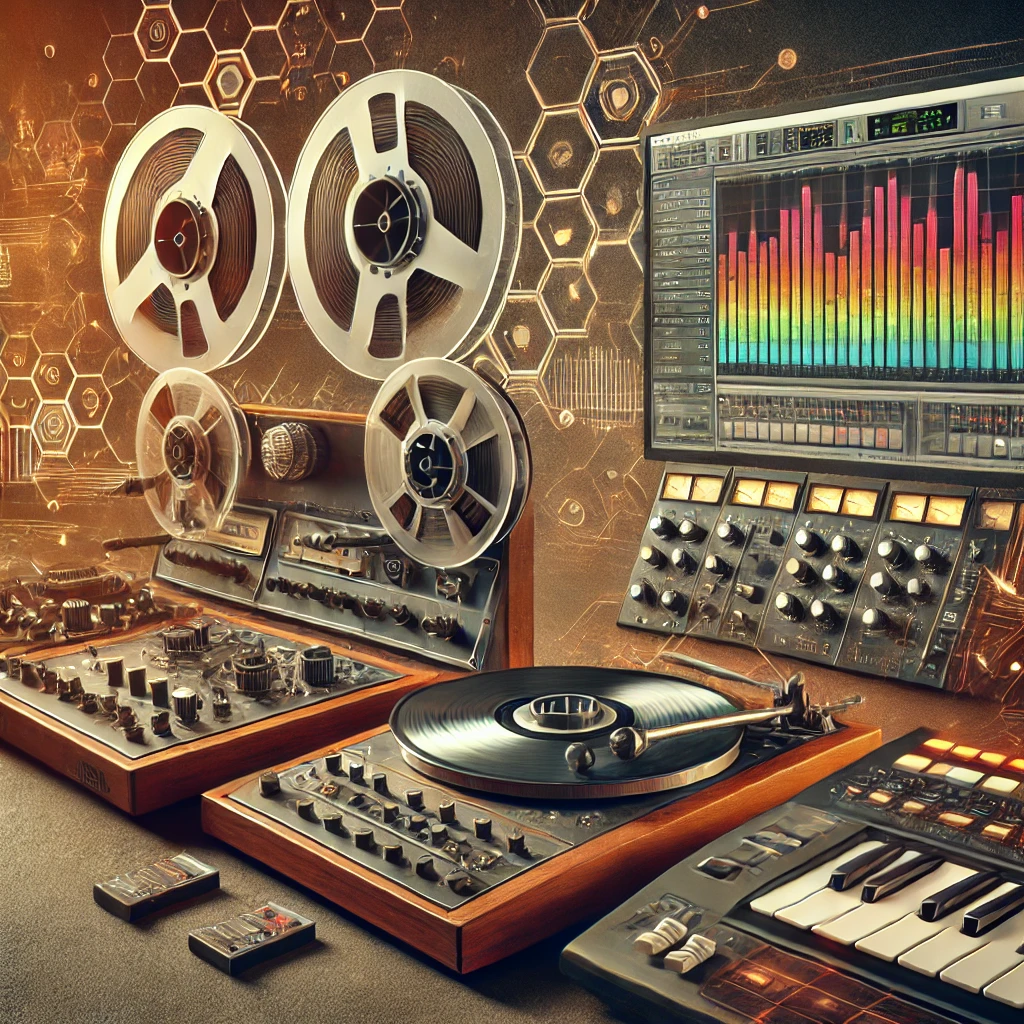In the world of audio engineering, technology is evolving faster than ever, and with it, the way we listen to and produce sound. One of the most exciting developments in recent years is the emergence of hybrid audio technologies. These systems combine the best elements of analog and digital audio, delivering a unique listening and production experience that merges the warmth and richness of analog with the flexibility and precision of digital. This article will explore what hybrid audio technology is, its key features, applications, and why it’s becoming a game-changer for audiophiles, musicians, and audio professionals alike.
1. What Are Hybrid Audio Technologies?
Hybrid audio technologies refer to audio systems that combine analog and digital components to enhance sound quality and flexibility. This hybrid approach seeks to capitalize on the strengths of analog audio, which is often praised for its warm, rich, and full sound, while integrating the advantages of digital audio, known for its precision, clarity, and versatility.
Analog vs. Digital: The Traditional Divide
For years, the debate between analog and digital audio has divided audio enthusiasts. Analog enthusiasts argue that digital audio lacks the warmth and character that analog sound provides. On the other hand, digital proponents point out the convenience, accuracy, and wide range of possibilities in digital audio production.
By blending both technologies, hybrid audio systems aim to resolve this divide, offering the best of both worlds: the authentic, organic sound of analog with the editing and manipulation capabilities of digital.
2. Key Features of Hybrid Audio Technologies
Hybrid audio systems offer a set of features that make them stand out in the crowded field of audio production. Let’s explore some of the standout characteristics that make hybrid audio a must-have for modern audio professionals and enthusiasts.
A. Warmth and Richness of Analog Sound
One of the most celebrated aspects of analog audio is its warmth and richness. Analog equipment, such as tape machines and tube amplifiers, naturally add subtle harmonic distortions that create a fuller, more vibrant sound. Hybrid systems maintain this quality by incorporating analog components like preamps or analog signal paths to preserve the warmth that digital equipment alone can’t replicate.
B. Digital Flexibility and Control
With digital audio, the possibilities are virtually limitless. Digital systems allow for precision editing, automation, and effects processing that are difficult, if not impossible, to achieve with analog systems. Hybrid audio technologies merge these two aspects, allowing producers to apply digital tools like equalization, compression, and effects without sacrificing the organic feel of analog sound.
C. Analog-Digital Conversion (ADC)
A critical component of hybrid systems is the analog-to-digital conversion process. High-quality ADC ensures that the warm, rich sound captured in the analog domain is accurately translated into the digital realm. Hybrid systems often employ premium converters to minimize data loss and maintain the integrity of the audio signal.
D. Low Latency Performance
Hybrid systems are designed to offer low latency, allowing for real-time recording, editing, and playback. By reducing the delay between the input and output of sound, hybrid technologies ensure that audio professionals can work with the immediacy of analog while benefiting from the advanced capabilities of digital processing.
3. Applications of Hybrid Audio Technologies
Hybrid audio technologies have widespread applications across various industries, from music production and live sound engineering to broadcasting and home audio systems. Here are some of the most common areas where hybrid audio systems are making an impact.
A. Music Production
In the music industry, hybrid audio systems are revolutionizing the way producers and engineers create and mix music. Many studios now incorporate hybrid setups, using analog mixing consoles and outboard gear alongside digital workstations (DAWs) like Pro Tools, Logic Pro, or Ableton. This allows producers to capture the nuance of analog sound while utilizing the flexibility of digital editing and effects.
B. Live Sound Engineering
For live performances, hybrid audio systems are becoming increasingly popular for their ability to deliver high-fidelity sound with the control and precision needed in real-time settings. Mixing engineers can use analog hardware to process audio signals while relying on digital systems for features like wireless control, automation, and integration with lighting and visual effects.
C. Broadcasting and Film
Hybrid audio systems are also widely used in broadcasting and film production. The warmth and character of analog sound can add depth to voice recordings, soundtracks, and sound effects, while digital systems provide the clarity and control required for editing and mastering. Many top-tier post-production studios rely on hybrid setups to achieve the best possible sound quality.
D. Audiophile Listening
For high-end audio enthusiasts, hybrid audio systems offer a listening experience that combines the best of analog and digital sound. Audiophiles can enjoy the immersive, organic feel of vinyl records or analog tapes while leveraging digital amplifiers and signal processing to improve clarity and precision. Hybrid audio systems cater to listeners who want to bridge the gap between the nostalgic sound of the past and the cutting-edge technology of today.
4. Benefits of Hybrid Audio Technologies
Why should audio professionals and enthusiasts consider adopting hybrid audio technologies? There are numerous benefits that these systems offer, making them a valuable investment for anyone serious about sound.
A. Best of Both Worlds
Perhaps the most significant advantage of hybrid audio technologies is that they provide the best of both analog and digital audio. The warmth, depth, and musicality of analog sound is combined with the precision, flexibility, and control of digital audio. Whether you’re producing a music track, engineering live sound, or simply enjoying a listening session, hybrid systems can deliver an experience that no single technology can achieve on its own.
B. Creative Flexibility
Hybrid systems allow for greater creative flexibility, enabling users to combine analog equipment like preamps, compressors, and equalizers with digital effects and editing tools. This gives audio professionals more options to shape the sound to their liking, resulting in more dynamic and interesting audio creations.
C. Future-Proofing
As technology continues to evolve, hybrid audio systems are positioned to remain relevant. By integrating both analog and digital components, hybrid systems are more adaptable to future innovations in both domains. This future-proof design ensures that studios and production environments can continue to leverage new technologies without losing the character and richness of analog sound.
D. Superior Sound Quality
Hybrid systems often deliver superior sound quality compared to all-digital or all-analog setups. By optimizing the strengths of both technologies, hybrid systems provide greater depth, nuance, and fidelity in the final output, making them ideal for professional music production, film scoring, and high-end audio listening.
5. Leading Brands in Hybrid Audio Technologies
As hybrid audio technologies continue to grow in popularity, several companies are leading the charge with innovative products that push the boundaries of sound. Here are some of the top brands in the industry:
A. Universal Audio
Universal Audio is a pioneer in analog-digital hybrid systems, offering products that combine analog emulations with cutting-edge digital processing. Their Apollo audio interfaces and UAD plugins have become industry standards for producers and engineers seeking high-quality sound.
B. SSL (Solid State Logic)
SSL is known for their hybrid mixing consoles that merge analog sound with digital control. The SSL Fusion processor, for instance, combines analog color and warmth with digital precision, offering a range of sonic possibilities.
C. Neve
Neve is legendary in the world of analog audio, and their hybrid consoles and outboard gear continue to set the benchmark for quality. Their products are often used in high-end studios that want to blend analog richness with digital flexibility.
D. RME
RME is a leader in audio interfaces, offering hybrid solutions that combine high-quality analog-to-digital conversion with digital processing. Their products are favored by audio professionals who require low latency and high-fidelity sound.
6. The Future of Hybrid Audio Technologies
As the demand for high-quality audio continues to grow, the future of hybrid audio technologies looks promising. Several emerging trends suggest that hybrid systems will continue to evolve and improve in the coming years.
A. Integration with Smart Technology
As the Internet of Things (IoT) continues to expand, hybrid audio systems may become more integrated with smart technology. This could include wireless control of analog components through digital apps or real-time monitoring and adjustments via mobile devices.
B. Greater Accessibility
As hybrid audio systems become more advanced, we can expect them to become more accessible to home studios and independent artists. Lower-cost, high-quality hybrid gear will allow a broader range of users to experience the benefits of combining analog and digital sound.
C. Sustainable and Eco-Friendly Audio Gear
In response to growing environmental concerns, future hybrid systems may be designed to be more sustainable and energy-efficient, reducing power consumption without sacrificing sound quality.
Conclusion: Why Hybrid Audio Technologies Are Changing the Game
Hybrid audio technologies represent a new frontier in sound engineering, offering a balanced mix of analog warmth and digital precision. Whether you’re a music producer, sound engineer, or audiophile, these systems provide the tools you need to create or experience high-fidelity sound without compromise.
By combining the best of both analog and digital worlds, hybrid systems are paving the way for more innovative, flexible, and high-quality audio production. As technology continues to advance, hybrid, audio technologies will undoubtedly play a key role in shaping the future of sound.
FAQs
1. What is hybrid audio technology?
Hybrid audio technology combines the warmth and character of analog sound with the precision and flexibility of digital audio, providing the best of both worlds.
2. How does hybrid audio technology improve sound quality?
By integrating analog components for warmth and digital systems for precision, hybrid audio systems offer superior sound quality compared to all-digital or all-analog setups.
3. Can I use hybrid audio technology in a home studio?
Yes, hybrid audio systems are becoming increasingly accessible, making them a great choice for home studios and independent artists.
4. What are some examples of hybrid audio gear?
Brands like Universal Audio, SSL, and Neve offer hybrid audio products, such as audio interfaces, mixing consoles, and signal processors.
5. What industries benefit from hybrid audio technologies?
Music production, live sound engineering, broadcasting, film production, and high-end audio listening are some of the industries that benefit from hybrid audio technologies.










